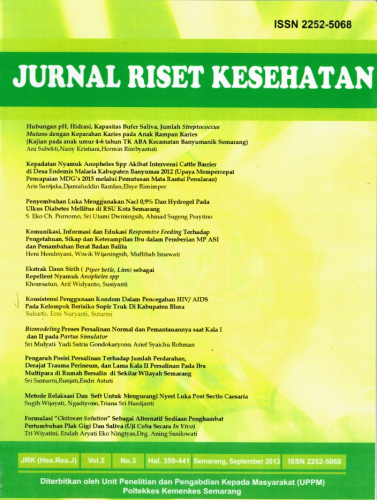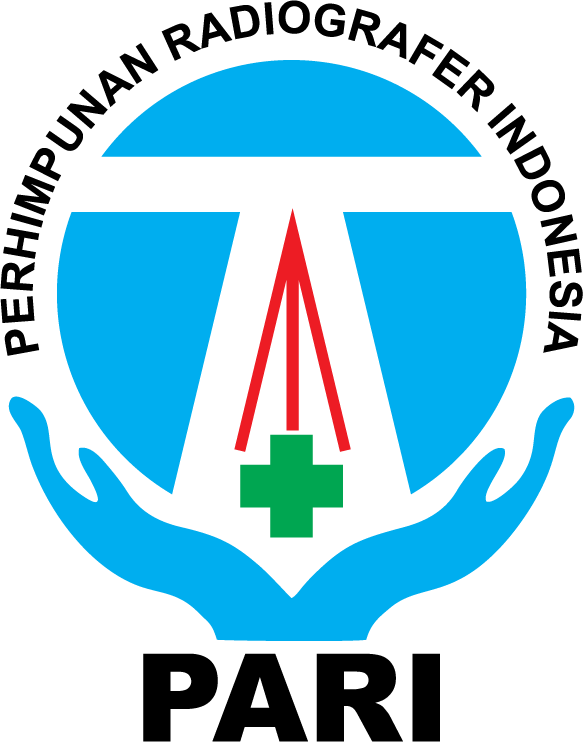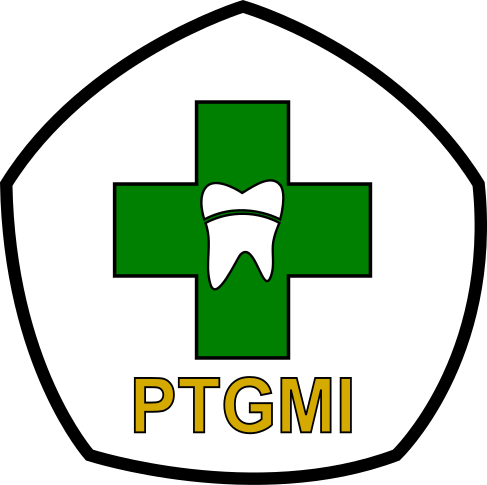ANALYSIS BETWEEN ANIMATED VIDEO AND DENTAL PHANTOM IN TOOTH BRUSHING EDUCATION
Abstract
Dental caries have been a problem in childhood. Poor knowledge causes poor dental hygiene. Health promotion is urged to conduct to give children of school age an understanding of how important is dental hygiene. Tooth brushing is a way to prevent dental caries. We initiated tooth brushing education research with a quasi-experimental design with a two-group pre-posttest design. The sample was taken with purposive sampling with 66 students in SDN Kalase, SDN Butong, and SDN Tateli located in a working area of Tateli Public Health Service, Minahasa, North Sulawesi, Indonesia. We employed animated video and dental phantom as the media and compare their effectiveness. First, we performed a normality test, the data is found not normally distributed. Hence, the Wilcoxon test was used to analyze whether the difference in the data exists, and the Mann-Whitney test was conducted to know whether the difference is significant. From the mean value of the Mann-Whitney test results, the effective of the methods is obtained. The results show that the Mann-Whitney test obtained Asymp. Sig (2 tailed) value of 0.000, less than a probability value of 0.005. Thus, there is a significant difference in knowledge level increase. The result of Mean value of a group with animated video is 49.26, higher than the dental phantom media group with only 17.74. So, in conclusion, animated video media is more effective than dental phantom media in improving students' knowledge level of tooth brushing.
Keywords
Full Text:
PDFReferences
Abed, R., Bernabe, E., & Sabbah, W. (2020). Family Impacts of Severe Dental Caries among Children in the United Kingdom. International Journal of Environmental Research and Public Health, 17(109), 1–10.
Achmad, H., Armedina, R. N., Timokhina, T., Goncharov, V. V, Sitanaya, R., & Riyanti, E. (2021). Literature Review : Problems of Dental and Oral Health Primary School Children. Indian Journal of Forensic Medicine & Toxicology, 15(2), 4146–4162.
Anil, S., & Anand, P. S. (2017). Early Childhood Caries: Prevalence, Risk Factors, and Prevention. Frontiers in Pediatrics, 5(July), 1–7. https://doi.org/10.3389/fped.2017.00157
Arkorful, V., & Abaidoo, N. (2014). The role of e-learning, the advantages, and disadvantages of its adoption in Higher Education. International Journal of Education and Research, 2(12), 397–410.
Atarbashi-moghadam, F., & Atarbashi-moghadam, S. (2018). Tooth Brushing in Children. Journal of Dental Materials and Techniques, 7(4), 181–184.
Boel, T., M. Zulkarnain, Nasution, R. O., Nainggolan, L. I., & Kartika, D. (2021). Improving oral and dental health through counseling, video and phantom demonstration during the Covid-19 pandemic to the Medan Belawan community. ABDIMAS TALENTA: Jurnal Pengabdian Kepada Masyarakat, 6(1), 74–80. https://doi.org/10.32734/abdimastalenta.v6i1.5142
Bramantoro, T., Rosandi, D. K., Rasuna, G., Wening, S., Berniyanti, T., Palupi, R., & Sosiawan, A. (2018). Effectiveness of 3D Pop-up Fairytale Books as a Medium of Education to Improve the Basic Knowledge of Dental and Oral Health of Children Aged 4-5 Years. In Proceedings of the 7th International Meeting and The 4th Joint Scientific Meeting in Dentistry (pp. 191–199).
Coro-montanet, G., Monedero, M. J. P., Ituarte, J. S., & Calvo, A. de la H. (2022). Train Strategies for Haptic and 3D Simulators to Improve the Learning Process in Dentistry Students. International Journal of Environmental Research and Public Health, 19(4081), 1–14.
Dali, T. A. ., Limbu, R., & Boeky, D. L. A. (2020). Increase in Knowledge of Dental Health Using Animated Video. Lontar : Journal of Community Health, 2(1), 21–25. https://doi.org/10.35508/ljch.v2i1.2774
Dorneles, L. L., Morelato, C. S., Mara, L., & Fonseca, M. (2020). Development of an animated infographic on Permanent Health Education. Rev. Latino-Am. Enfermagem, 28(e3311), 1–13. https://doi.org/10.1590/1518-8345.3536.3311
Fugill, M. (2013). Defining the purpose of the phantom head. European Journal of Dental Education, 17, 1–4. https://doi.org/10.1111/eje.12008
Halkett, G. K. B., Mckay, J., & Shaw, T. (2011). Improving students ’ confidence levels in communicating with patients and introducing students to the importance of history taking. Radiography, 17(1), 55–60. https://doi.org/10.1016/j.radi.2010.02.006
Husnifa, R. (2017). The Use of Animation Pictures to Improve Students’ Vocabulary of Seventh Grade at MTS TPI Sawit Seberang. The State Islamic University of North Sumatera.
Jati Dyah Utami, W., Nugraheni, H., & Wiradona, I. (2021). Animated Video Media as an Alternative for Oral Health Telepromotion on Elementary School Students. Volatiles & Essent. Oils, 8(5), 3852–3861.
Khalidiyah, H. (2015). The Use of Animated Video in Improving Students’ Reading Skill ( A Quasi-Experimental Study of Seventh Grade Student at A Junior High School in Jalancagak, Subang ). Journal of English and Education, 3(1), 59–79.
Limanto, S., Purba, S., & Oeitheurisa, M. (2019). Animated video as a health promotion tool for community supplementary feeding. In International Conference on Informatics, Technology, and Engineering (pp. 37–43).
Mona, D., & Azalea, F. W. (2018). Leaflets and pocketbooks are educational tools to change the level of dental health knowledge. Bali Medical Journal, 7(3), 760–763. https://doi.org/10.15562/bmj.v7i3.1172
Nor, M., Ali, S., Pawanteh, L., Mustaffa, N., Hashim, H., & Ahmad, A. L. (2013). New Audience Message Absorption via Audio Visual Technology New Audience Message Absorption via Audio Visual Technology. Asian Social Science, 9(8), 107–115. https://doi.org/10.5539/ass.v9n8p107
Nurdianti, D. A., Ramdan, I. M., & Satriana, M. (2019). Tooth Brushing Big Book as Health Promotion Media in Improving Knowledge and Practice to Brush Teeth on 2th Grade Elementary School. Advances in Social Science, Education and Humanities Research, 224(January), 28–31. https://doi.org/10.2991/esic-18.2019.7
Rossi, G. N., Sorazabal, A. L., Salgado, P. A., Squassi, A. F., & Klemonskis, G. L. (2016). Toothbrushing Procedure in Schoolchildren with No Previous Formal Instruction: Variables Associated to Dental Biofilm Removal. Acta Odontol. Latinoam, 29(1), 82–89.
Sanjaya, A. N., Suwargiani, A. A., & Wardani, R. (2019). Comparison between audiovisual media and simulation on the toothbrushing skills of elementary school students. Padjadjaran Journal of Dentistry, 31(1), 177–183. https://doi.org/10.24198/pjd.vol31no3.22862
Sariyem, Santoso, B., & Supriyana. (2017). Effectiveness of Animation Media toward Teaching Deaf Students on Dental Hygiene. ARC Journal of Dental Science, 2(4), 1–4.
Setiawati, F., Darwita, R. R., Fadillah, F., Adiatman, M., Soekanto, S. A., & Sjarkawi, G. A. (2020). Effectiveness of dental health education intervention using the 16-surface tooth brushing program among 7–9-year-old schoolchildren in Indonesia. Pesquisa Brasileira Em Odontopediatria e Clinica Integrada, 20, 1–7. https://doi.org/10.1590/pboci.2020.144
Sinor, M. Z. (2014). Comparison between Conventional Health Promotion and Use of Cartoon Animation in Delivering Oral Health Education. International Journal of Humanities and Social Science, 1(3), 169–174.
Sopiatin, S., Susanto, A., Metta, P., & Rusyanti, Y. (2020). Oral Health Knowledge Among Of Student Elementary School in Sumedang City, Indonesia. International Journal of Medical Science and Clinical Invention, 07(03), 3–7. https://doi.org/10.18535/ijmsci/v7i03.02
Trubey, R., Moore, S. C., & Chestnutt, I. (2015). Children’s Toothbrushing Frequency : The Influence of Parents ’ Rationale for Brushing, Habits and Family Routines. Caries Res., 49, 157–164. https://doi.org/10.1159/000365152
World Health Organization (WHO). (2020). Oral health, (December), 1–6.
Yanti, G. N., Alamsyah, R. M., & Natassa, S. E. (2017). Effectiveness of dental health education using cartoons video showing method on knowledge and oral hygiene of deaf children in Yayasan Karya Murni Medan. International Journal of Applied Dental Science, 3(2), 86–90.
DOI: https://doi.org/10.31983/jrk.v11i1.7089
Article Metrics
Refbacks
- There are currently no refbacks.
Copyright (c) 2022 Jurnal Riset Kesehatan



















































